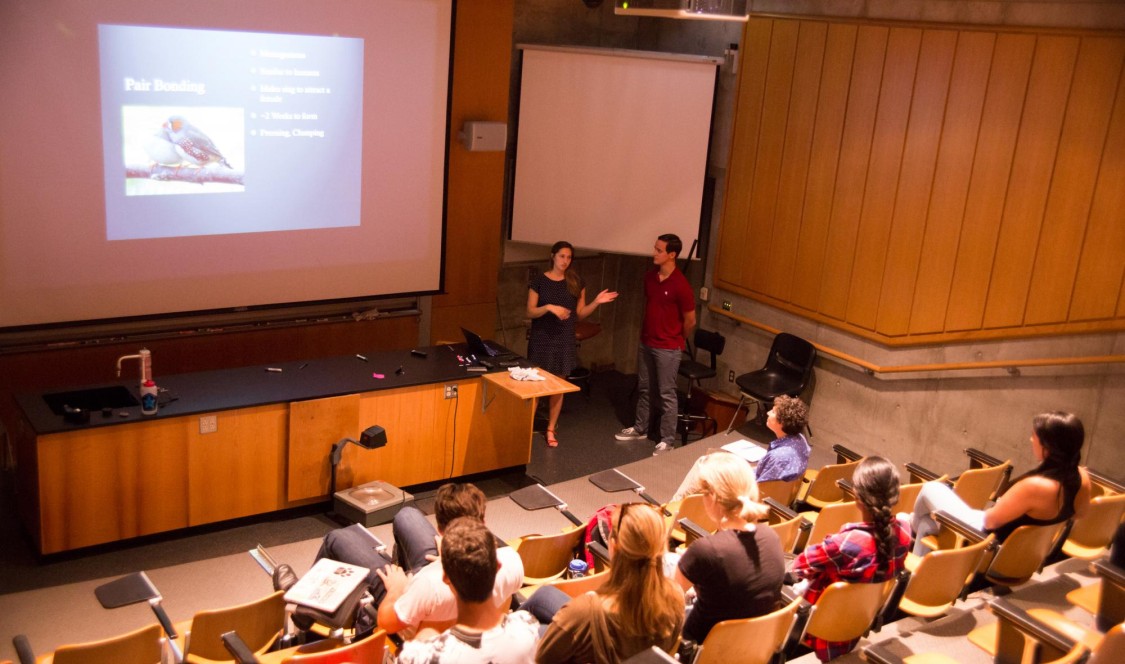More than 75 highly motivated students from Claremont McKenna, Pitzer and Scripps Colleges participated in the Keck Summer Science Research Symposium held at the W.M. Keck Science Department.
These symposia at Keck have been held for about a decade and are comprised entirely of student presentations of work performed in the science labs at Keck and abroad. The research was grouped into nine categories that represent all the major fields of science; everything from science on the scale of molecules to natural ecology studied in situ.
The Symposium kicked off with a Poster Session which gave students a chance to meet one-on-one with the researchers to discuss and better understand their motivations and scientific findings. Afterwards, the researchers broke into smaller groups (corresponding to the nine categories) to give a more in-depth analysis into their processes and conclusions.
According to Babak Sanii, assistant professor of chemistry at the Keck Science Department and one of the organizers of the Symposium, all students who performed summer research at Keck are asked to take part, as well as those who performed research off-campus that they will use towards their senior thesis.
He said the process of being selected for summer research varies. “For myself, I meet with interested students from all three colleges in February and we see if my projects match their interests, then I may ask them to read a related paper so they get a better idea of the work we do, and if it's a fit then we work with our various funding agencies to get them summer positions.”
For Prof. Sanii, the Symposium is a great way for faculty and students to learn about the diverse research being conducted at Keck and elsewhere. “It also gives budding researchers a sense of what is possible and it’s a rigorous presentation experience for all of our students,” Prof. Sanii said. “In fact, most students conduct practice presentations over the summer just to get ready for the Symposium.”
Kristen Munoz ’17, a Chemistry and Spanish dual major at CMC wanted to gain more experience in the lab and carry out her own research project. Her participation in the Symposium began when she spoke with Prof. Sanii about the projects he supervises. She then decided to apply for a research grant through The Rose Hills Foundation.
“Upon receiving the grant, I also agreed to give a presentation at the symposium about the research I conducted during the summer (Applications of membrane gradients: diffusion, phase separation, and protein binding),” she said. “So, as my summer research experience was coming to a close, my partner Chen-min (Steven) Hung and I created a poster for the work that we did in those 10 weeks and we presented at the symposium.”
According to Munoz, CMC science students should not be the only ones interested in the research. “CMC is filled with brilliant people,” she said. “These students have worked so much and have put in endless hours into their projects. You'd be amazed at some of the crazy stuff that's going on in some of these labs! It's great to see the research they conducted be created into a beautifully designed poster that encapsulates all their hard work and dedication. CMC students – whether they’re in the sciences or not – will get to learn more about topics outside of what they study, and that can only be good.”
Michael Swift ’16, a Biochemistry major at CMC, presented on “Identification of RNA Binding Proteins Associated with H19 lncRNA Translation Avoidance.” Simply put, Swift hopes his research will provide insight into how to stop the progression of gastric cancer, which is highly associated with the increased presence of H19 in the cell.
“The value of the symposium is essentially the same as any symposium, communication,” Swift said. “Though the work undergraduates like me have done in just one summer is not likely to be groundbreaking, it is important to learn how to communicate our findings to a variety of people: those in our particular field, a scientist in general, and especially the lay person. Additionally, since mostly seniors were presenting their research it is a good way for first years and sophomores to see that kind of research that they may end up doing in a few years.”
In Swift’s view, science is a simultaneously beautiful and frustrating process that almost never works in the way people want it to. “The cleverest, most persevering scientists can always make some sense of their data, so that even in ‘failure’ we can find real results,” he said. “I think people would find that when they communicate with the young promising scientists at Keck, who will hopefully be the ones to alleviate many of society’s woes from hereditary diseases to climate change, that they would come away with more hope for the future.”
About W.M. Keck Science Department
The W.M. Keck Science Department is the interdisciplinary home to the biology, chemistry, environmental science, and physics faculty for Claremont McKenna, Pitzer, and Scripps colleges. The department is administered cooperatively and is housed within an 81,000-square-foot Center, located at the intersection of the three colleges. The department offers more than a dozen discrete degree options, including dual-degree programs in partnership with schools of engineering and majors in conjunction with disciplines outside the sciences. The W.M. Keck Science Department provides comprehensive, interdisciplinary instruction in small class settings and numerous opportunities for students to conduct research. Our graduates enter a significant range of careers and enjoy acceptance into prestigious graduate research and health science programs.

